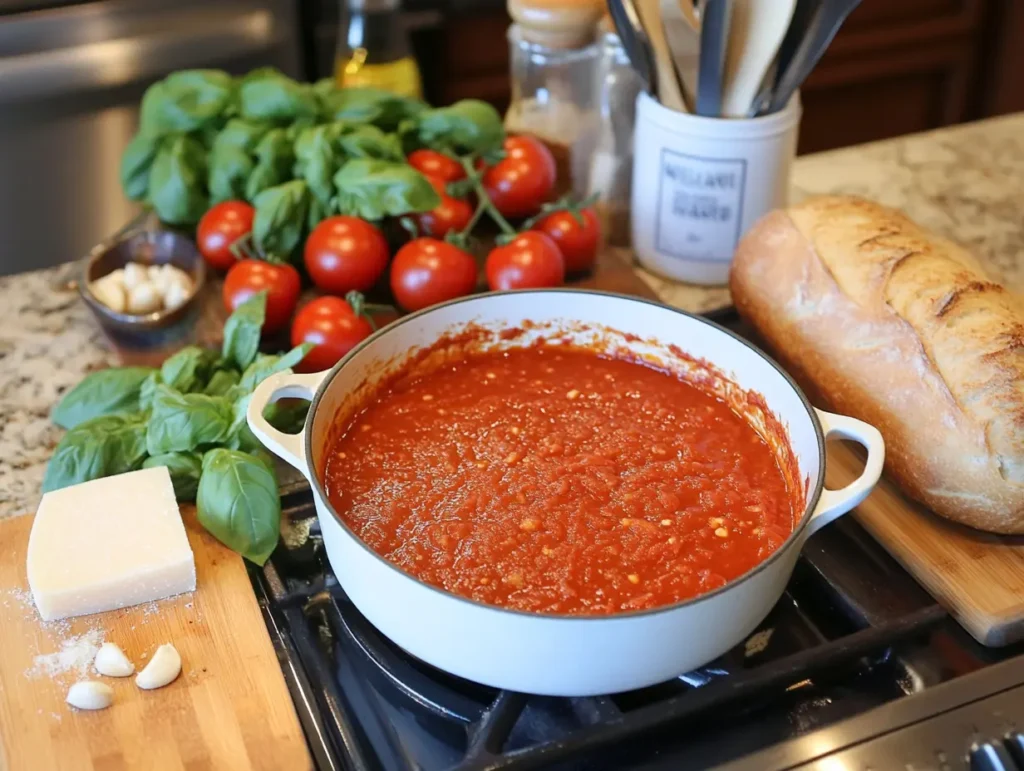Marinara sauce is a timeless classic that serves as the foundation for many Italian dishes. But have you ever wondered how to make marinara sauce taste better? By focusing on high-quality ingredients, proper techniques, and creative enhancements, you can transform a simple sauce into a flavorful masterpiece. Whether you’re upgrading a store-bought jar or crafting your own, small adjustments can make a world of difference.
Table of Contents

Not sure where to start? For a creative application, explore this halibut marinara recipe for ideas on pairing marinara sauce with fish
Understanding the Basics of how to make marinara sauce taste better
What is Marinara Sauce?
Marinara sauce is a traditional Italian tomato-based sauce typically made with tomatoes, olive oil, garlic, and fresh herbs. It is celebrated for its versatility, serving as a base for pasta, pizza, and even seafood dishes. Originating from southern Italy, marinara sauce is known for its fresh, vibrant flavor and quick preparation time.
For a detailed historical overview, visit the Wikipedia article on marinara sauce.
Why Focus on Enhancing Flavor?
While marinara sauce is simple to make, it can often lack depth or balance. Enhancing its flavor through high-quality ingredients and proper cooking techniques ensures a sauce that is rich, nuanced, and irresistible.
And the question is How To marinara sauce taste better
Key Ingredients for how to make marinara sauce taste better
1. Tomatoes: The Foundation
The quality of your tomatoes can make or break your marinara sauce. Fresh, ripe tomatoes or premium canned varieties like San Marzano tomatoes provide a sweet and tangy base. These tomatoes are prized for their low acidity and rich flavor, making them ideal for sauces.
- Tip: Avoid canned tomatoes with added sugar or preservatives. Look for whole, peeled varieties for the best results.
If you’re exploring the difference between fresh and canned tomatoes, check out this guide on marinara ingredients.
2. Olive Oil and Butter
Extra virgin olive oil is a must for authentic marinara sauce. It adds depth and a fruity richness to the sauce. For a twist, consider adding a small amount of butter at the end to round out the flavors with a creamy finish.
- Olive Oil Uses: Sauté aromatics and herbs.
- Butter Addition: Perfect for balancing acidity in highly tangy tomatoes.
3. Aromatics: Garlic, Onions, and Shallots
Garlic is a quintessential ingredient in marinara sauce. Sautéing garlic and onions in olive oil before adding tomatoes builds a fragrant and flavorful base. Shallots can also be used for a sweeter, more subtle aromatic note.
- Pro Tip: Avoid browning garlic, as it can introduce bitterness.
Techniques to how to make marinara sauce taste better
1. Simmer for Optimal Flavor
Simmering marinara sauce allows the ingredients to meld together, creating a balanced and rich taste. A quick simmer results in a fresher, lighter sauce, while a longer simmer develops a deeper flavor.
- Simmer for 30–45 minutes for homemade marinara.
- For store-bought sauce, a 15-minute simmer with added ingredients works wonders.
2. Deglaze for Depth
Deglazing involves lifting caramelized bits from the pan using liquid. This step adds complexity and depth to the sauce. Options include:
- Red Wine: For robust, earthy flavors.
- White Wine: For a light, crisp finish.
- Stock: Adds richness without overpowering the sauce.
3. Layer Flavors Gradually
Layering flavors step-by-step ensures a balanced marinara. Start with aromatics, add tomatoes and herbs, then finish with olive oil, cheese, or fresh basil for a final burst of flavor.
Creative Additions for how to make marinara sauce taste better
1. Parmesan Rinds
Simmering Parmesan rinds in the sauce infuses it with savory, umami notes. Remove the rind before serving for a smooth texture.
2. Dairy Enhancements
Adding cream or mascarpone transforms marinara into a creamy variation, perfect for heartier pasta dishes or baked ziti.
3. Vegetables and Meats
For a richer marinara:
- Vegetables: Sauté mushrooms, zucchini, or bell peppers.
- Meats: Ground beef, Italian sausage, or pancetta add protein and depth.
4. Sweet and Tangy Balances
Balance the natural acidity of tomatoes by introducing sweet and tangy elements:
- Sweet Additions: A teaspoon of sugar or a drizzle of honey.
- Tangy Notes: A splash of balsamic vinegar or lemon juice.
For more ideas, check out flavor pairing tips that can also enhance marinara sauce.
Practical Customization Tips
Adjust Consistency
- To Thicken: Simmer uncovered or stir in tomato paste.
- To Thin: Add vegetable stock, water, or reserved pasta water.
Adjust Acidity and Sweetness
If the sauce is too acidic, add a pinch of sugar or a pat of butter. For overly sweet sauces, balance with vinegar or lemon juice.
Dietary Modifications
For a vegan version, use olive oil and skip butter or cream. Gluten-free marinara requires no additional adjustments, but always check labels on pre-made sauces.
FAQs
How do you make marinara sauce less acidic?
To reduce acidity, simmer the sauce longer, add a small pat of butter, or introduce a pinch of sugar.
What herbs work best in marinara sauce?
Fresh basil is a classic choice, while oregano, parsley, and thyme add variety and depth.
Can you use butter instead of olive oil?
Yes, butter can be used for richness, but combining it with olive oil creates a more balanced flavor.
What’s the best way to store marinara sauce?
Refrigerate in an airtight container for up to 5 days or freeze for longer storage.
Conclusion
Marinara sauce is more than just a simple tomato blend—it’s a versatile canvas for culinary creativity. By focusing on high-quality ingredients, proper techniques, and thoughtful enhancements, you can elevate your marinara sauce to restaurant-quality levels. Whether simmering Parmesan rinds, adding fresh basil, or balancing acidity with butter, small changes can yield extraordinary results.
For more marinara inspiration, explore Recipes Mint’s halibut marinara recipe or learn about the difference between marinara and pasta sauce. Dive deeper into marinara’s history and variations on its Wikipedia page.
With these tips, your marinara sauce will transform every dish it touches into a culinary masterpiece!
